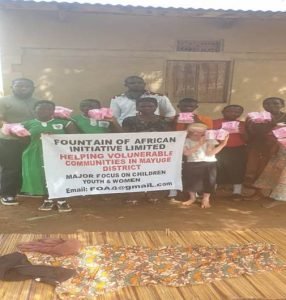Under the SRHR program, FAII focuses awareness, linkages and referrals for family planning and HIV prevention, school SRH programs, health worker capacity building and community-led advocacy for better health services.
 This program in integrated within our empowerment program whereby the exiting groups play a key role in mobilizing communities for awareness and participating in advocacy.
This program in integrated within our empowerment program whereby the exiting groups play a key role in mobilizing communities for awareness and participating in advocacy.
a. Awareness, Linkages and referrals
We work with Community Health Workers to provide information, referrals and linkages to health facilities and follow up. CHW outreach programs contribute to identifying and getting mothers into health facilities in remote and inaccessible areas. We partner with CSOs and private sector to do direct service provision as well as enable women and youth participate in advocacy for improved service delivery. We measure our contribution through women and youth accessing quality RH services, functionality of community based health supportive system and participation of women and youth in social accountability.
We promote use of family planning for women and girls to avoid early and unwanted pregnancies. We do this through awareness and linking our participants to health service providers. We also distribute condoms to promote safer sex practices. We also advocate for youth friendly spaces at health facilities to increase service utilization among youth.
FAII promotes HIV prevention We enhance home-based care of women living with HIV prevention, care & support, COVID-19 management, post lock down consequences. FAII key activities under HIV prevention including Assessment of women households using the ministry of gender, labour and social development tools, index testing of the women and males with unknown HIV status to achieve the 95.95.95, refresher trainings for Village health teams in key issues fundamental to the ARV/ART and COVID-19 prevention, facilitation of VHTs with materials to support home based care and support of women households, Hygiene and COVID-19 management trainings among households through their VSLA/Cooperatives/adherence groups as well as use of media to conduct community awareness on mental health, HIV prevention
b. School SRH programs
 We also engage children in school who have reached reproductive age. This is because young people have limited accurate information on SRHR services like STIs, birth Control evidenced by the high age specific unmet need of 30.4% highest among all age groups and high prevalence of self-reported STIs of 23% (F) and 13% (M) (UBOS 2016) and only 14% of the girls below 15 years had correct knowledge on fertile period. We conduct school awareness Sexual Reproductive Health campaigns and HIV prevention through film shows, music and drama and school clubs. We work with school senior teachers to provide referrals and linkages for children to health facilities as well as facilitating health workers to provide information and services to children.
We also engage children in school who have reached reproductive age. This is because young people have limited accurate information on SRHR services like STIs, birth Control evidenced by the high age specific unmet need of 30.4% highest among all age groups and high prevalence of self-reported STIs of 23% (F) and 13% (M) (UBOS 2016) and only 14% of the girls below 15 years had correct knowledge on fertile period. We conduct school awareness Sexual Reproductive Health campaigns and HIV prevention through film shows, music and drama and school clubs. We work with school senior teachers to provide referrals and linkages for children to health facilities as well as facilitating health workers to provide information and services to children.
c. Health worker capacity building
Community and mainstream health workers play an important role in ensuring women and youth have access to proper care. We build their capacity in human rights based approaches to health service provision and task-shifting to share work load and improve timely access to health service provision.
d. Community-led advocacy for better health services.
Advocacy is premised on the citizen awareness of their rights and responsibilities provided for in the national and legal frameworks for better service provision. We underscore the importance of empowering women, youth and other community members including males, health workers, local leaders to participate in evidence based planning, monitoring, reporting and holding duty bearers accountable for social services provided. Using community engagement tools such as the Community score care, PETs, SWOT/PESTEL analyses and among other others, mothers and community members participate in advocacy initiatives for improved service provision. We also draw on our existing networks to amplify women and youth’ voices on local, national and international levels through main stream and social media as well as physical campaigns.
